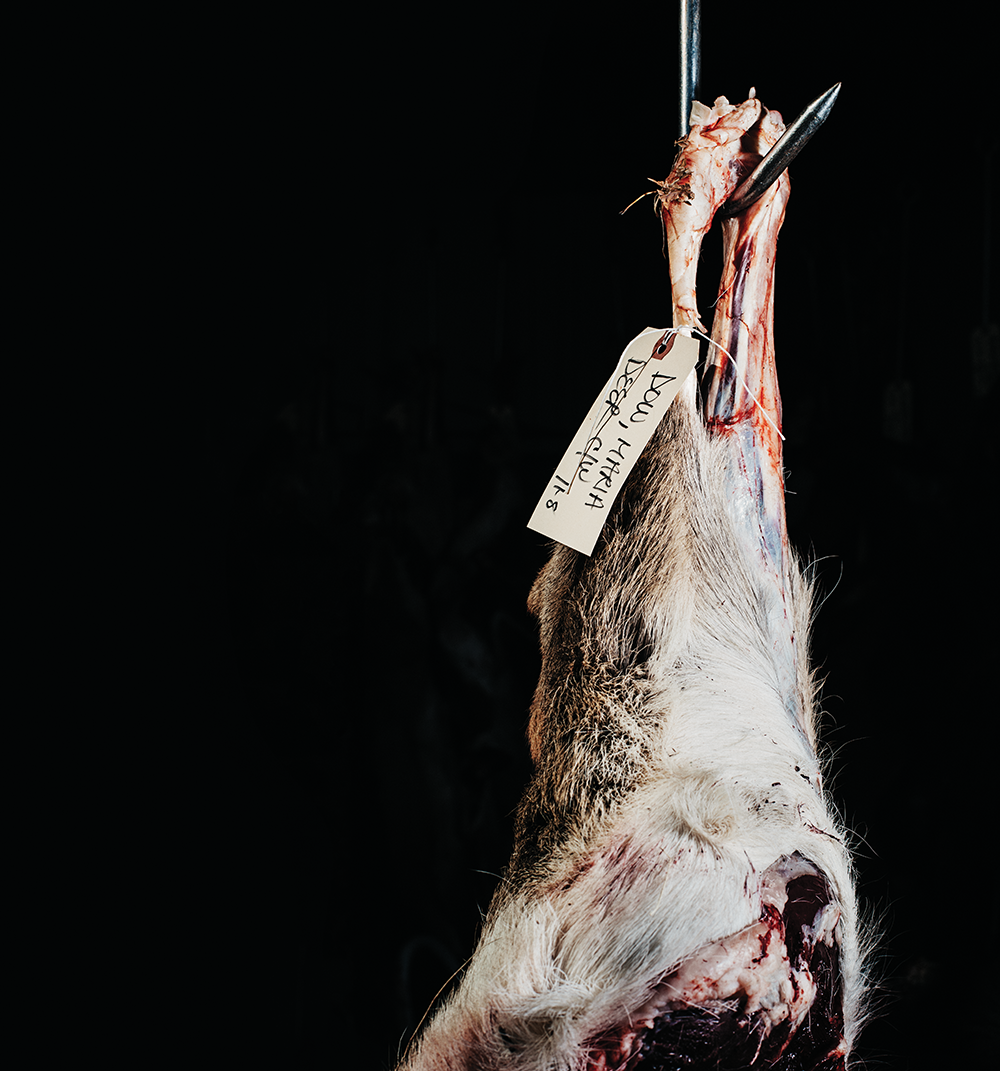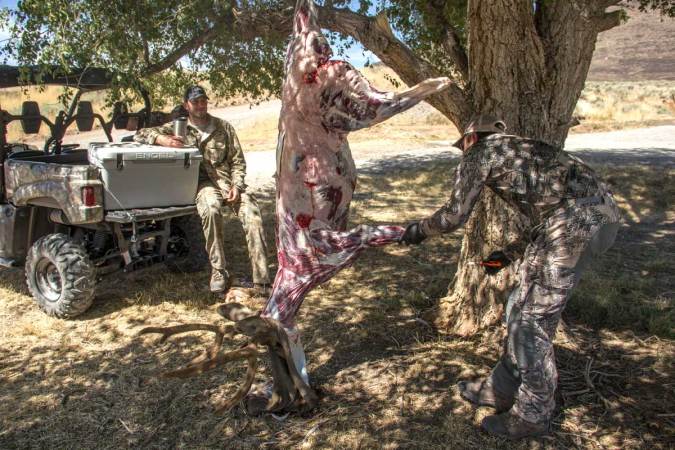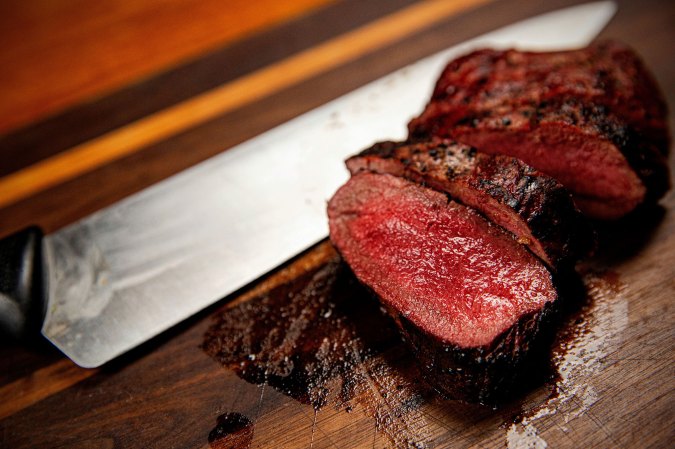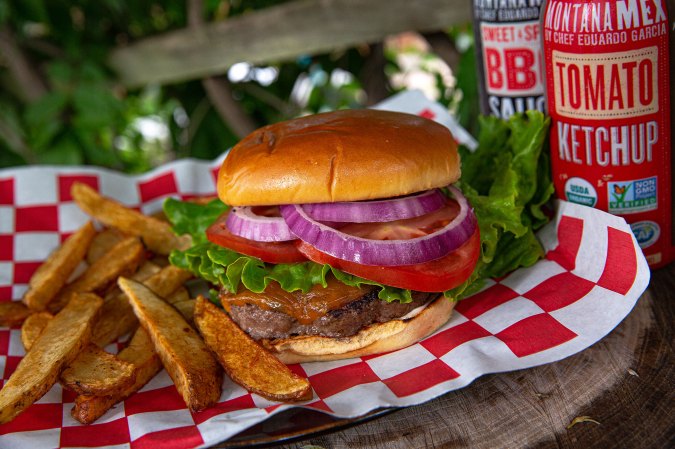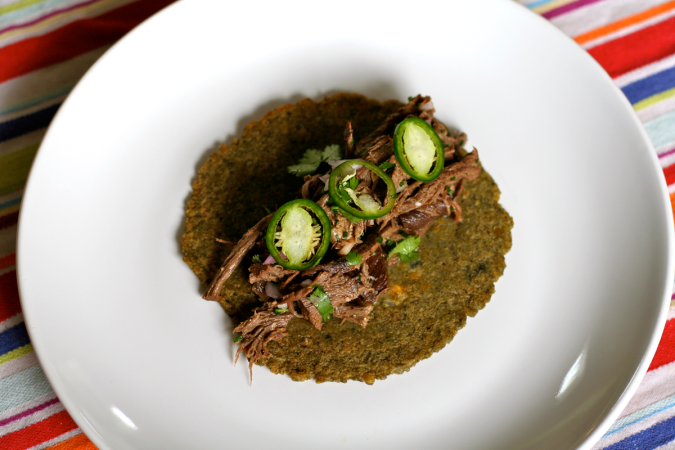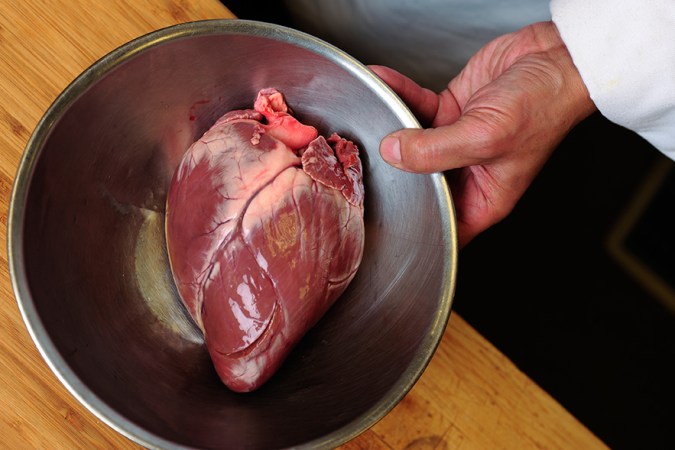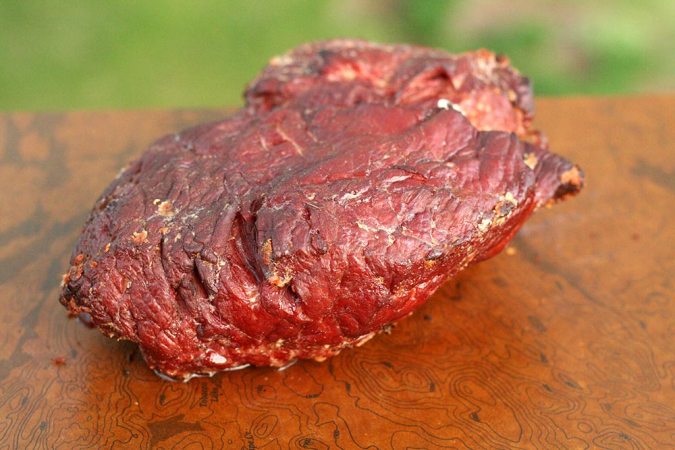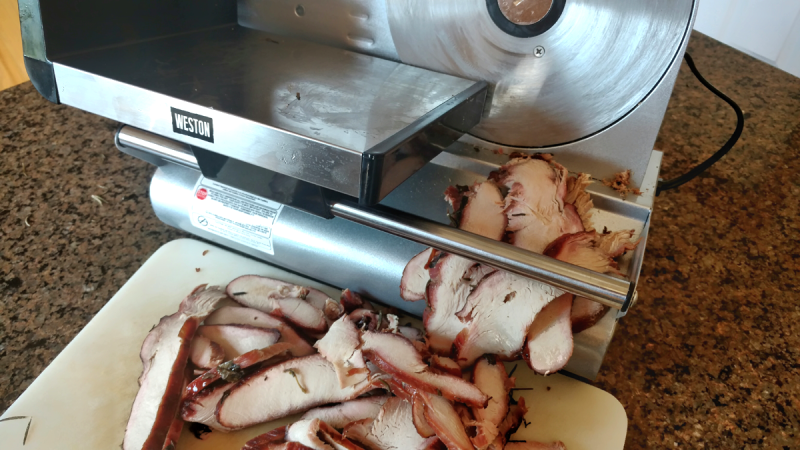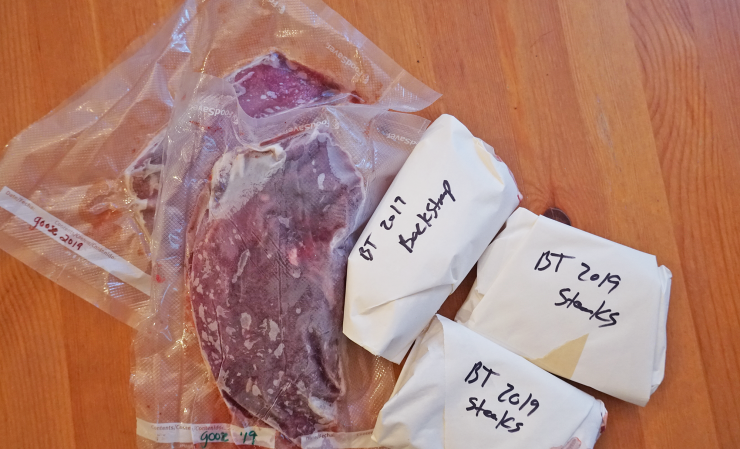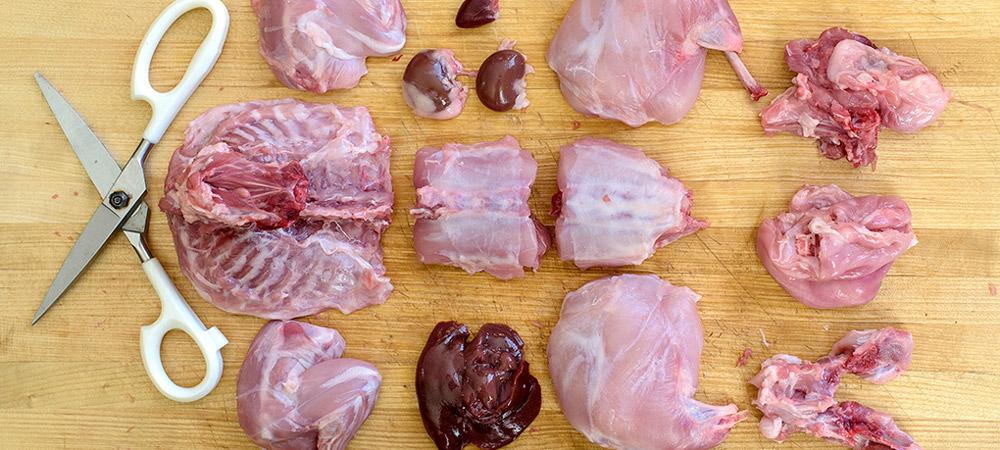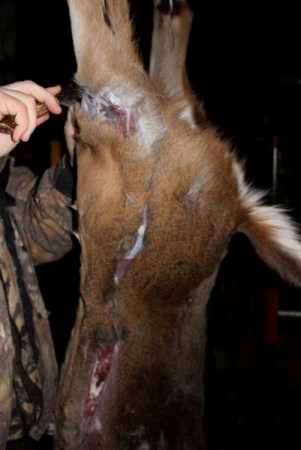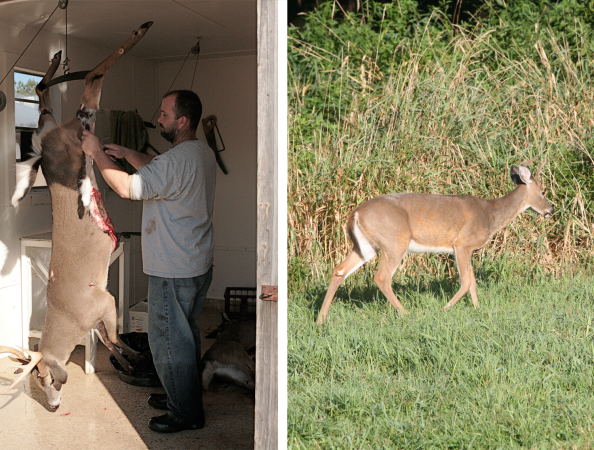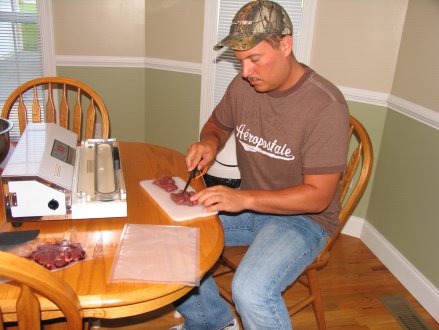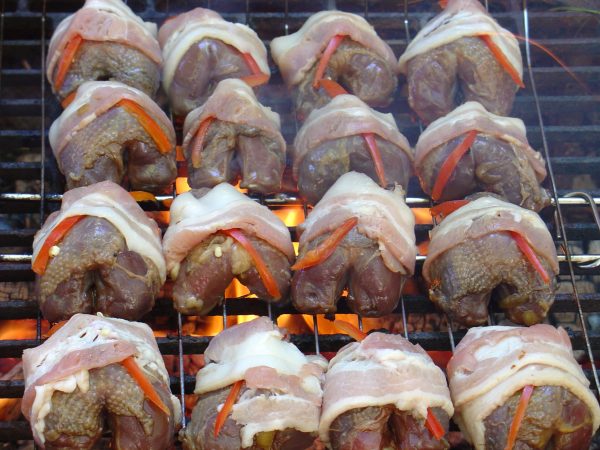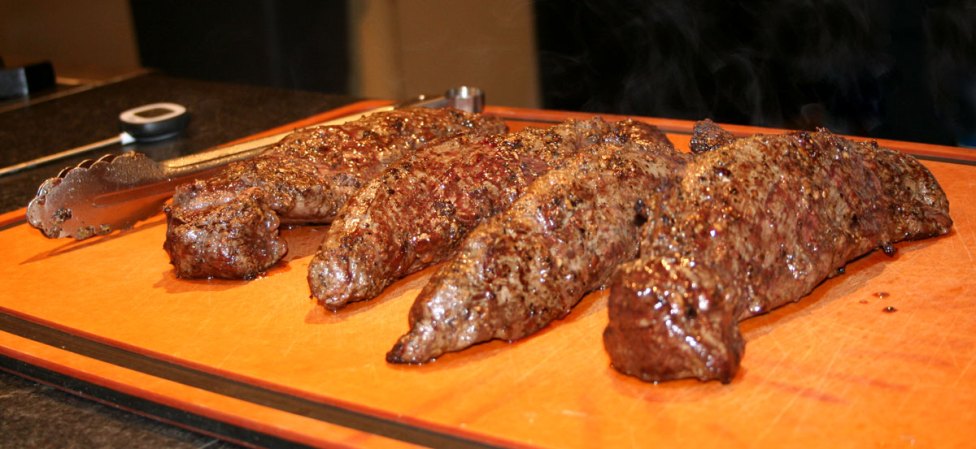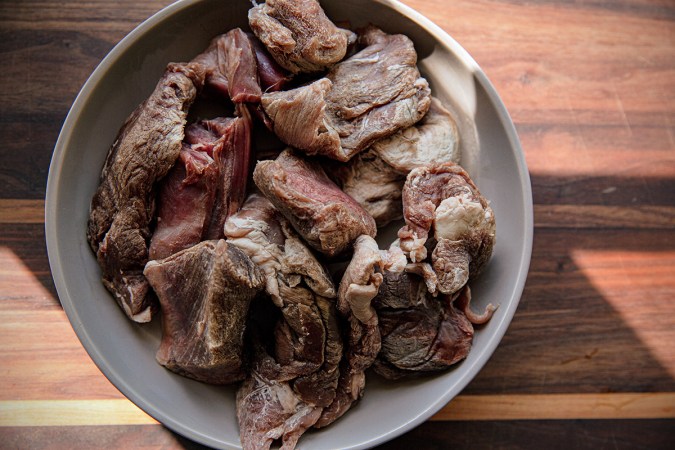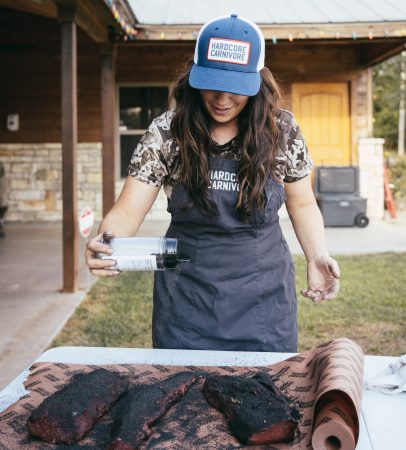Behind a wall of head-less, upside-down hanging elk carcasses, Buzz Jones stands on a stepladder trimming around each animal’s hock before he hooks the loose flap of skin to a motorized hide puller. Within seconds, the elk is skinned, left wearing nothing but some fat, a whole lot of meat, and a bloody manila tag with the hunter’s name.
Fourteen years ago, Buzz paid me $7.50 an hour to stand at a cutting table for 10 hours a day with a meat hook in one hand and a knife in the other. Now, on a chilly weekend in early November, I’m back at Yellowstone Processing to see how this family business has thrived over the years, and to get a hands-on reminder of exactly what it takes to turn a hunter’s trophy into steaks, roasts, and burger.
The Meat Man
At 61, Buzz is a sixth-generation Montanan and seasonal business man—concrete in the summer, head ski-lift operator in the winter, and butcher in the fall. His father was a year-round butcher in Bozeman, Mont. After work, he’d pick up Buzz to make house calls during hunting season. “We’d be out until 10 or 11 at night,” says Buzz. “I’d wrap and trim burger.” Buzz was in first grade.
A barrel of a man with a graying red beard, Buzz could be the freewheeling little brother Santa Claus never had. With a tattered sweatshirt, he has an easy chuckle that echoes through the labyrinth that is Yellowstone Processing. The shop sits right off I-90 between Bozeman and Livingston, just north of Yellowstone National Park. Buzz’s blade is typically the first stop on an elk’s journey from carcass to chops, steaks, and burger. And he’s the first guy to greet hunters as they back up to the intake area.
“I like meeting people and being a part of the hunt,” says Buzz. “People bring their kids in, and we become part of the hunting story.”
This afternoon, the pickups outside the shop begin to line up as the first cold front of the season slams into town, kicking up clouds of dirt. Everyone standing outside tucks their head inside upturned coat collars like frightened turtles.
A few hunters run into the shop, where Buzz’s wife, Patti, is there to take their order. A native of nearby Butte, Patti has been working alongside Buzz for the past 15 years. During hunting season, they live in an apartment attached to the shop and take animals at nearly every hour of the day. Hunters request sausage or jerky, and if they killed an elk, they typically want a little of everything. All of the sausage and jerky is made in the back, where speakers blast David Allen Coe almost as often as they do Bob Marley.
Waiting patiently in the crowd of camo is elementary school teacher Ashley Capobianco with her first deer. She got married about a month ago, and her husband, Nick, is by her side.
“She dumped it at 150 yards,” he says with a smile. “Right through the heart. She dressed it out herself, which is funny because she can’t get blood drawn without passing out.”
Ashley laughs and adds that she told her class at Hyalite Elementary she was going hunting and they wished her luck. Turns out fourth-graders are decent luck charms.
Inside, Patti is chatting with a hunter but spots me out of the corner of her eye. She drops her pen and gives me a hug. It’s been a while since we last saw each other. Back in the day, my job was to trim sinew, fat, and hair off of chunks of meat thrown on the table. I drove home the first night using only my right hand; my left had cramped up like an eagle’s talon. I made it through that entire season, though, which isn’t always the case. Back then, there were maybe seven employees, most of them related to Buzz and Patti. Now, Buzz has at least 30, only eight of whom are brand-new. And even though he starts them at $11 an hour now, I don’t think I could ever sling meat on that scale again for an entire season.
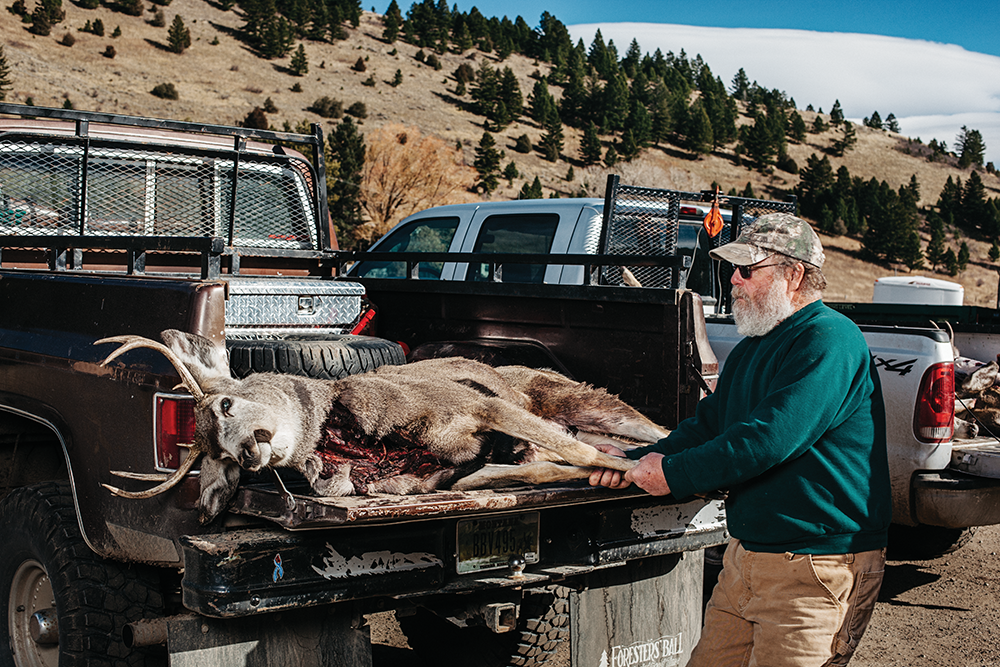
Butcher Burns
“There’s a certain type of person who thrives in a place like this,” says assistant manager Ryan Harris, who’s been with the shop for eight years. “People who aren’t afraid of work, work here. We’ve had our share of people not come back after their first lunch break.” Harris wears an elk tooth around his neck. At 12, he arrowed his first elk while hunting with his dad. At 28, he’s still looking to kill another one. After the season is over, he will head up to Bridger Bowl, the local ski hill, to work as a lift operator for his ninth season. “I think of this place as ski bums working for ski bums,” he says.
For Harris, Yellowstone Processing is more than a job. When his mom had some health issues and had to move in with him, the only person he felt he could talk to about it was Patti. “I work for them because I know they care about me and the rest of us,” Harris says. “I bust my ass for them, even when Buzz gets ornery. And with every season that I come back, I feel more like family.”
Harris works as a breaker on the weekday shift. After the animal is skinned, his job is to cut off the four quarters, backstraps, neck meat, brisket, flank steaks, and any other good-looking meat. Bloodshot meat gets trimmed and tossed in the dumpster. There just isn’t time to trim away the jellied clumps to save a couple of pounds of trim. As he slices, he tosses meat onto one of two tables, where six cutters wait to do the job I used to do, with one very big difference: Instead of hosing off hair and bloodshot with cold water, the cutters use a propane torch to lightly burn off any hair. The aroma isn’t inviting, but it beats working cold and wet all day.
Harris stresses that for hunters to get the most out of their meat, it all starts with that first, and hopefully only, shot. “So much meat is wasted on a bad shot,” he says. Once down, the animal needs to be gutted completely, including cracking open the chest to get the esophagus out. “If you leave in any organs—especially the windpipe—it traps heat, and those enzymes work quickly to destroy your meat.”
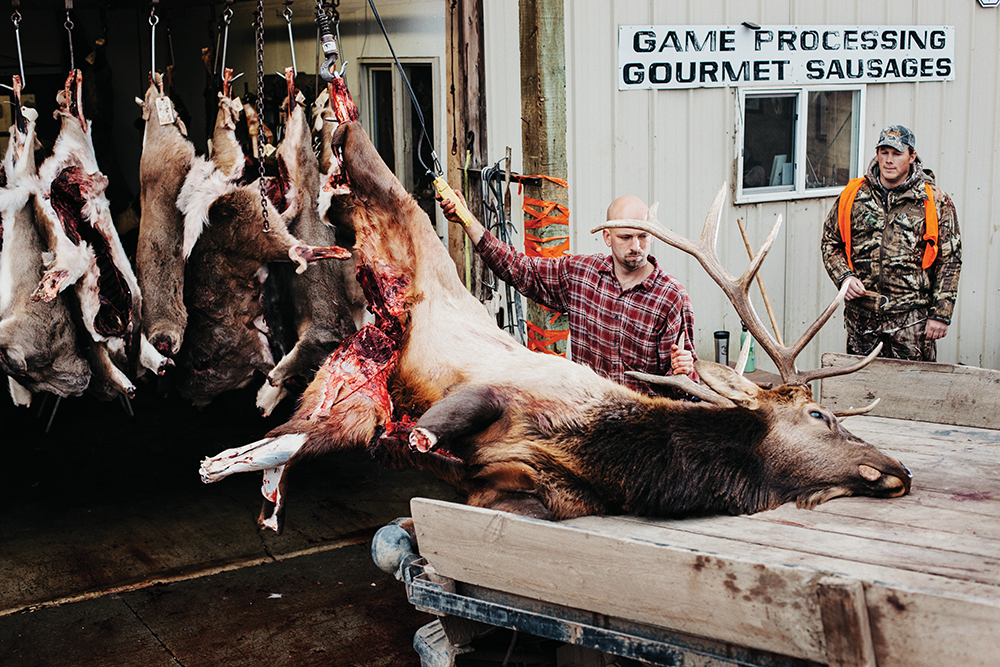
Family Business
From the cutting table, the meat makes its way into a bus tub, typically two for a deer and five for an elk. The manila tag follows on top of the meat. On the weekends, Koby Richins, Buzz’s son-in-law, works the steak table, making clean chunks of meat into chops, steaks, or burger trim. During the week, his wife and cutting room manager, Jackie Jones, works the cutting table. She’s been working here since they opened. Their seven-year-old daughter, Sahara, was practically pitching in by the time she could walk.
“We have pictures of her at a few months old, drooling all over herself, sitting in her little bouncy chair while Jackie cut steaks,” says Koby. “When Jackie needed to take care of Sahara, someone would step in and keep cutting. As a family, we all help out. It’s the whole it-takes-a-village mentality. That’s how it is here.”
Sahara comes in on the weekends to help make sausage. “She knows where her food comes from,” says Koby. “And that’s important, because there’s a huge disconnect from where the food comes from and the whole process of growing and raising your own food, especially in our society. Everything is right there at the grocery store.”
Jackie comes to work after dropping Sahara at school. It’s a way to get a paycheck. But for Jackie, it’s also some well-needed social time for a stay-at-home mom. “Having the crew around brings some excitement to my life,” she says with a laugh. And while the crew is made up predominantly of men, that doesn’t bother her. “I was raised by my dad, and when the testosterone level gets too high, that’s when I plug in my headphones. It can get pretty crude back there.”
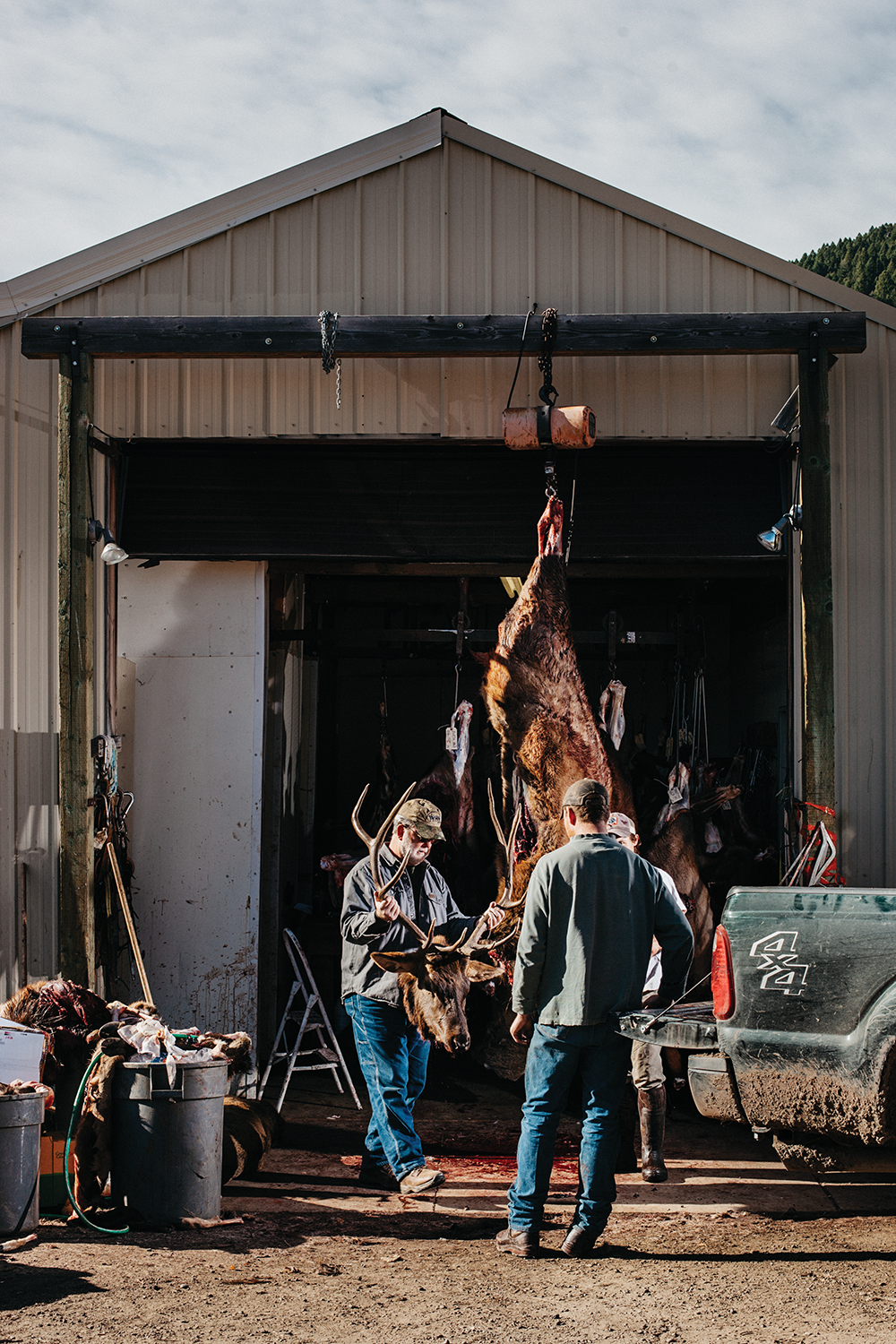
Most of the time, the front shoulders are turned into burger; the hindquarters are where steaks and roasts sit in one giant mass until Jackie unfolds it. Following the natural seams of the meat, she separates rounds from sirloin, trims sinew, and then moves on to backstraps.
Depending on the order, the meat and tag will go back in their tubs to the packaging area. Steaks get vacuum-sealed, while the trim gets ground into burger or sausage. Or it will go to Buzz’s new $60,000 smoker, located where Sahara’s nursery used to be. For most hunters who fill their tag early in the season, it can take only a couple of weeks to get their meat back, barring any specialty jerky or sausage orders. Once the season gets moving, it could take a couple of months or more.
Giving Back
Some hunters choose to donate some or their entire animal to local food banks. And thanks to Safari Club’s Sportsmen Against Hunger program, as well as the Hunters Against Hunger program, the cost of processing is covered. Montana legislation, passed in 2013, offers hunters a voluntary hunter donation check-off on each license application for the Hunters Against Hunger program. In its first season, the program generated $70,000 and more than 35,000 pounds of wild game. Compared to some states—like Iowa, which receives more than 300,000 pounds of donated meat—it may not seem like a lot. But for hungry Montana families, it makes a difference.
“It has proven so successful because it echoes with Montanans—the hunters, the processors, and the people who use the food pantries,” says Jeff Gutierrez, chief programs officer at Montana Food Bank network. Hunters from all walks participate in the program, such as Janice and Don Ledbetter of Dallas. Don, an attorney, killed his elk earlier in the year. On their trip back up to Montana, Janice killed a good bull and a great mule deer, both her first. They donated 68 pounds of burger to the Food Bank. All told, Yellowstone Processing sent 6,000 pounds of meat, mostly deer and elk, to their local food bank in 2014.
Calm Before the Storm
As the sun starts to set on another weekend of Montana’s hunting season, there is a lull in the action at the shop. The successful morning hunters are long gone. The successful evening hunters are still afield, packing out their elk and deer, and calling all their buddies. For the workers, it’s a time to grab a quick dinner, a smoke, or a cup of coffee.
Before long, the wind picks up again and snowflakes move in every direction but down. A line of truck headlights begins to migrate in our direction through the oncoming storm.
My family is in one of those trucks, coming to pick me up. I want them to meet Buzz and Patti and the crew. My kids, 5 and 2, are cautiously curious about the piles of heads, antlers, rib cages, and hides. On the way home, they will pepper me with questions.
But before I leave, Buzz and I shake hands. All joking aside, he tells it to me straight: “We got to keep this going. Hunting really isn’t a bad way to raise your family.”
I couldn’t agree more.
THE STATS
_The 2014 hunting season at Yellowstone Processing _
6,000 pounds of meat sent to the Food Bank. Mostly deer and elk, but some antelope, moose, and bear.
149,764 pounds of steaks, chops, and roasts cut
36,400 pounds of sausage and jerky produced
TOOLS OF THE TRADE
You only need one knife to process an animal. But as with any task, having the right tools makes it a lot easier. To butcher an animal from start to finish, I like to use the knives illustrated here.
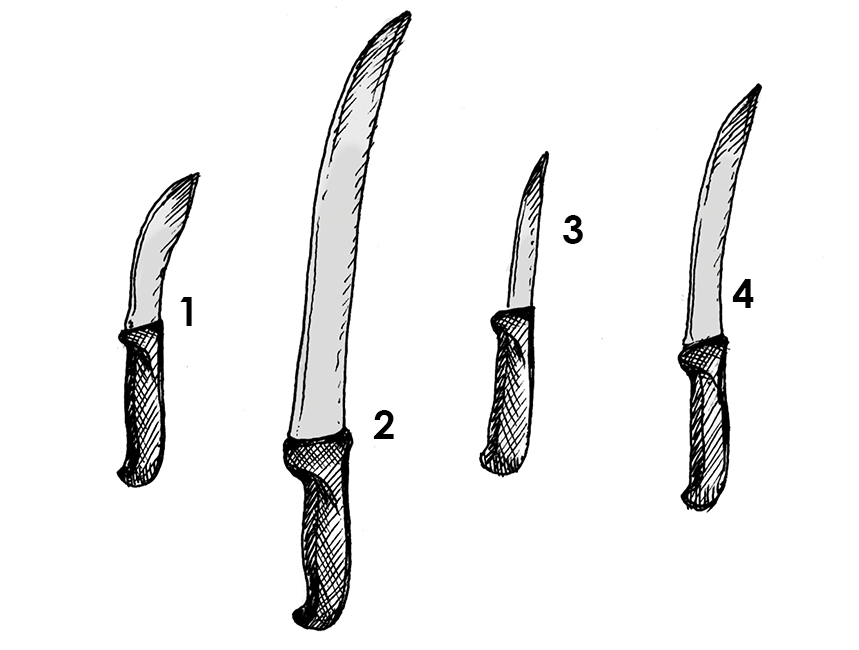
1] the skinner
The key characteristic of a skinner is the curved tip. It allows you to quickly separate the hide from the meat without puncturing the hide—if you’re careful. Once you try this knife, you’ll never go for your pocketknife to skin again. It also can be used to carve off fat with minimal damage to the meat.
2] the breaking knife
If the skinner is short, curvy, and stocky, this is the slimmer and longer, yet still curvy, version. The extra length helps you get into places like the hip joint when quartering. The knife is also good for cutting and butterflying steaks and separating muscle groups of large roasts in the hindquarters.
3] the boning knife
If you’ve already quartered your animal to pack it out, then you’re going to need to get that meat off the bone. A boning knife is shorter and lacks the curves of the breaker. As you work your way around a femur or scapula, you’ll appreciate the knife’s flexibility.
4] the fillet knife
To trim the silver skin from roasts and backstraps, I like to use a very sharp fillet knife. The ample flexibility helps you cut just under the silver skin and keeps a lot of meat from ending up in the dog bowl.
BREAK IT DOWN
Once you have the animal skinned, the real fun begins. Breaking an animal into workable chunks is like riding a bike: Do it once and you’ll remember how to every season. Hang the carcass head-down by its hocks for the entire process. I like to use a meat hook in my left hand.
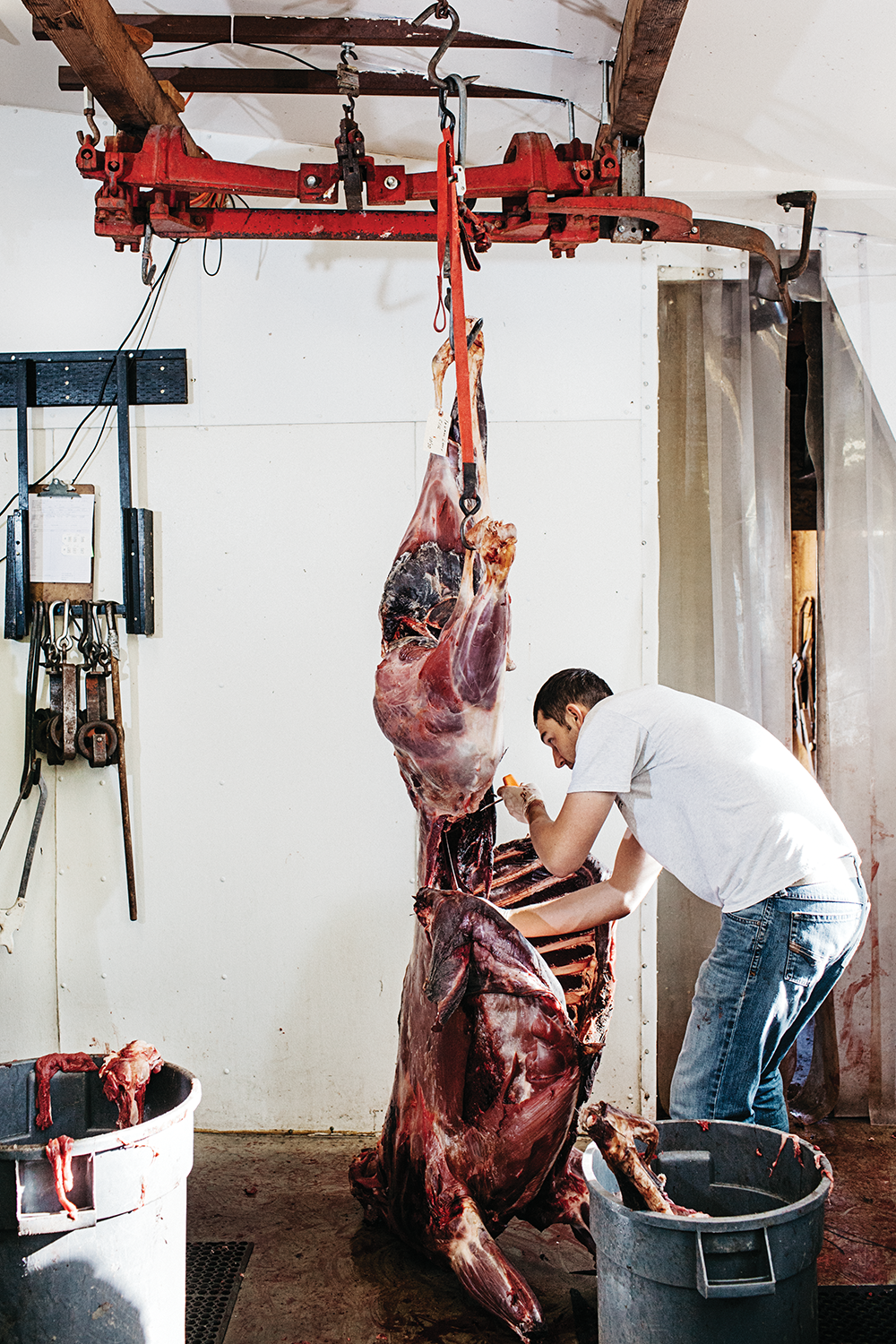
Front Shoulders
Removing the shoulder blades is easy. Pull one leg out to the side and slice away under the armpit.
Backstraps
These choice steaks run along the spine. With the deer facing away from you, draw an imaginary line from the end of the rib cage around to the top of the hindquarters. (Remember, the deer is hanging upside down.) Make your first horizontal cut here. Then, with a vertical cut, closely follow either side of the spine as far down as you can. I take my cuts well into the neck. Finally, insert your knife back into the first horizontal cut. Turn it 45 degrees so the blade points to the ground and sits on top of the ribs. Skim your knife along the top of the ribs as you cut toward the floor. Your backstrap should peel away easily.
Trim
At this point, trim rib and neck meat for burger. Before you bring over the garbage can, grab those tenderloins inside the carcass.
The Hind
With the hindquarters remaining, you have a decision to make. You can cut the meat off each quarter while the carcass hangs, saw through the middle of the pelvis, or remove each quarter from the pelvic bone individually. I prefer the last option because it’s also what I typically end up with after quartering an animal in the field.
To get the quarter off the pelvis, find the ball-and-socket joint by following the femur from the knee. Slice the tendons that hold the ball to the joint. Now, find the pelvic bone and slowly shave the meat away using your knife. There is more meat there than you think.
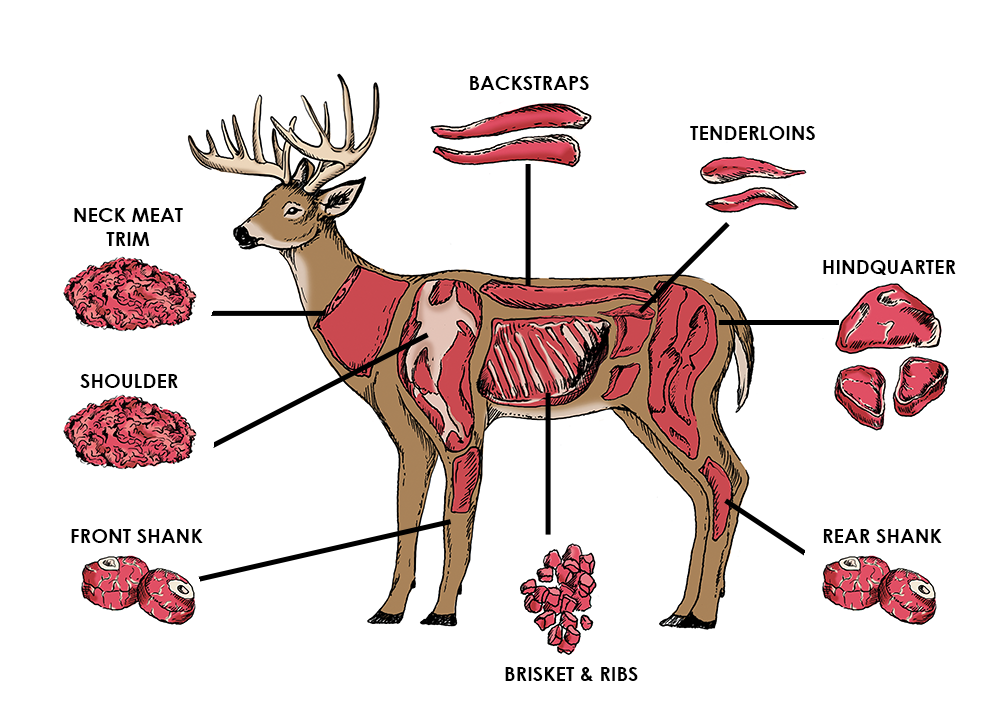
THE CUTS
A lot of meat lovers throw around terms like “eye of round,” “brisket,” and “T-bone,” and that’s great. But how does that translate to game animals? If you’re like me, chances are all you need to know are what cuts are good for grilling, grinding, or stewing in the slow cooker. Consider this Venison Cuts 101.
Front shoulder and trim meat becomes burger or sausage. Backstraps and tenderloins are either butterfly-cut for deer or cut into 1- to 2-inch-thick medallions for elk.
The hindquarter holds the most varied options of roasts and steaks, and that’s where I focus much of my time when butchering.
To bone out the hindquarter, find the ball joint on the inside of the leg. At that joint, trace the bone with your knife, cutting the meat as you work your way down to the knee joint. Work your knife around the entire femur until you trim all the meat away. (If you’re feeling ambitious, saw through the lower leg bone for the shanks.)
Then make two cuts: one just above the knee joint and one behind. Ideally, the meat should fall off in one big chunk. On your butcher table at home, break down the chunk using a fillet knife, following the natural lines of the connective tissue. Soon you’ll see all those steaks and roasts unfold before your eyes.
You can really do no wrong with any cuts off the hindquarter if you follow the natural lines of the muscle. Some I cut into steaks, while others I leave whole for the slow cooker. Bottom round and eye round make good stews and pot roast. Top sirloin and top round are best for steaks and sautéing.
Neck meat trim // Grind neck meat for burger, sausage, or jerky.
Shoulder // The majority of your ground meat comes from the shoulders.
Front shank // Avoid trying to trim off shanks. Instead, saw through the leg.
Rear shank // Shank meat goes in the slow cooker.
Brisket and ribs // Can be ground for burger or sliced for stir-fry.
Hindquarter // When in doubt, cut good-looking hindquarter meat into steaks. Follow the connective tissue lines. You can’t go wrong.
Tenderloins // The true trophy from any successful deer hunt.
Backstrap // Leave whole and grill for your pals or butterfly and save for yourself.
SAVE BLOODSHOT MEAT
Unless you shoot an animal in the head, you’re going to have to deal with some amount of internal destruction caused by your bullet. Typically, you encounter one or two mangled front shoulder blades. At the processor, a lot of that wreckage goes in the trash. It is full of bone, lead fragments, and bloodshot—that snot-textured mass of bloody mess.
If you’re cleaning meat outside, use a hose with a spray nozzle and stick it inside the bullet hole to flush what you can, then trim any undesirable bone or destroyed meat. You don’t want a bullet or bone chip to go through the grinder. Salvage what you can.
If you shoot an animal in the hindquarters, the same technique as above applies. Keep in mind that you lose a lot of choice cuts with poorly placed shots. More time at the range should be on your agenda for next season.
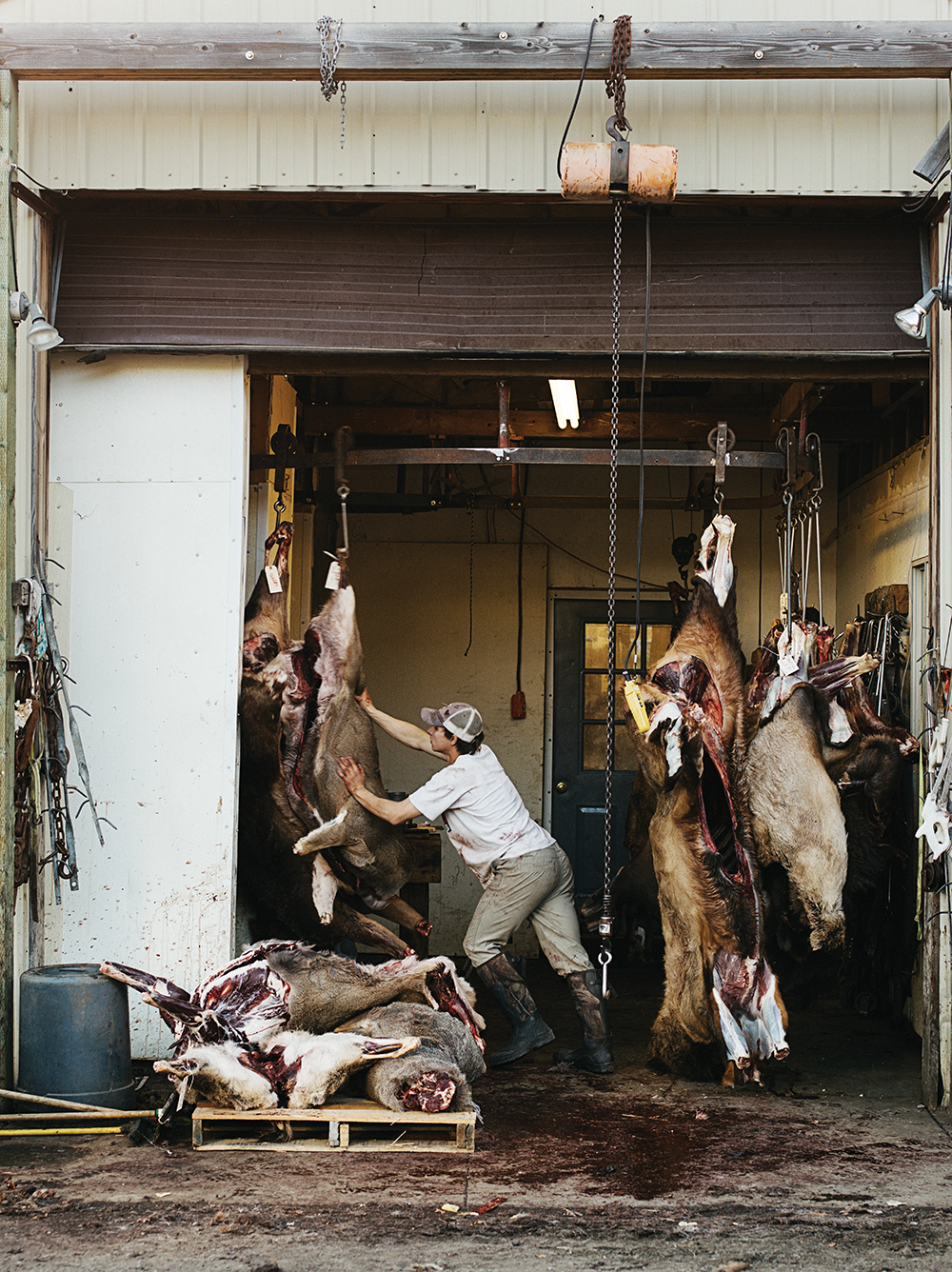
AGING EXPLAINED
Hanging meat allows the enzymes within the muscles to break down complex proteins. This helps enhance flavor and tenderize the meat. Plus, it gives you a chance to relive the hunt with the neighborhood while drinking a beer in the garage.
Ideally, you’ll want the ambient temperature where the meat is hanging to be around 40 degrees. If it’s much warmer than that, bacteria will grow more rapidly and it will shorten your hang time as those enzymes work more aggressively. If it’s very warm, let your nose be your guide. If it starts to smell odd—even a little—it’s time to cut it up. If things get sticky or slimy, that’s another indication. If it gets warm in the day but stays cool at night, I’ll put some frozen water jugs in the chest cavity. And if at all possible, I keep the hide on until I’m ready to cut it up. It keeps the meat clean and prevents the outer layers of meat from drying out.
If I shoot a young buck, I’ll hang it only a couple of days. A rutted-up mature stud? I’ll let it hang for a week if the temperature is ideal. One thing you should never do is let the animal freeze solid with the hide on. It halts the aging process and makes it a drudgery to skin.
5 WAYS TO WASTE MEAT
1. Making a poor first shot. The quality and amount of meat you harvest all comes down to that first shot. An animal shot once in the vitals, without its even knowing you’re there, is the best thing you can do.
2. Delaying field dressing. The longer you leave in blood and guts, the more likely the processor will call the game warden and report you for wanton waste. You have to get the entrails out and open up your animal if you want to eat the best-tasting meat around.
3. Letting it sit on the ground overnight. Hang quarters in a nearby tree or shove some logs underneath the carcass. You need cool air to flow around the animal.
4. Leaving too much hair and tendon. The best way to get kids to stop eating venison is having them find a hair in their sloppy Joe or, even worse, a piece of silver skin they could chew on for days. Clean your meat with a passion for quality.
5. Not sharing it with friends and family. Are you really going to eat all that? I’m sure you could, but where’s the fun in that?
